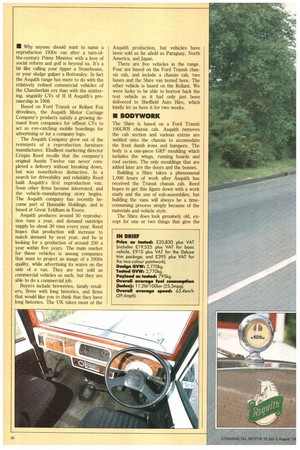IN Why anyone should want to name a reproduction 1930s
Page 30

If you've noticed an error in this article please click here to report it so we can fix it.
van after a turn-ofthe-century Prime Minister with a love of social reform and golf is beyond us. It's a bit like calling your tipper a Stonehouse, or your sludge gulper a Bottomley. In fact the Asquith range has more to do with the relatively refined commercial vehicles of the Chamberlain era than with the stuttering, ungainly CVs of H H Asquith's premiership in 1908.
Based on Ford Transit or Reliant Fox drivelines, the Asquith Motor Carriage Company's products satisfy a growing demand from companies for offbeat CVs to act as eye-catching mobile hoardings for advertising or for a company logo.
The Asquith Company grew out of the remnants of a reproduction furniture manufacturer. Ebullient marketing director Crispin Reed recalls that the company's original Austin Twelve van never completed a delivery without breaking down, but was nonetheless distinctive. In a search for driveability and reliability Reed built Asquith's first reproduction van. Soon other firms became interested, and the vehicle-manufacturing story begins. The Asquith company has recently become part of Htuutable Holdings, and is based at Great Yeldham in Essex.
Asquith produces around 50 reproduction vans a year, and demand outstrips supply by about 30 vans every year. Reed hopes that production will increase to match demand by next year, and he is looking for a production of around 250 a year within five years. The main market for these vehicles is among companies that want to project an image of a 1930s quality, while advertising its wares on the side of a van. They are not sold as commercial vehicles as such, but they are able to do a commercial job.
Buyers include breweries, family retailers, firms with long histories, and firms that would like you to think that they have long histories. The UK takes most of the Asquith production, but vehicles have been sold as far afield as Paraguay, North America, and Japan.
There are five vehicles in the range. Four are based on the Ford Transit chassis cab, and include a chassis cab, two buses and the Shire van tested here. The other vehicle is based on the Reliant. We were lucky to be able to borrow back the test vehicle as it had only just been delivered to Sheffield Auto Hire, which kindly let us have it for two weeks.
• BODYWORK
The Shire is based on a Ford Transit 100LWB chassis cab. Asquith removes the cab section and various extras are welded onto the chassis to accomodate the front dumb irons and bumpers. The body is a one-piece GRP moulding which includes the wings, running boards and roof section. The only mouldings that are added later are the doors and the bonnet.
Building a Shire takes a phenomenal 1,000 hours of work after Asquith has received the Transit chassis cab. Reed hopes to get this figure down with a work study and the use of sub-assemblies, but building the vans will always be a timeconsuming process simply because of the materials and vehicle style.
The Shire does look genuinely old, except for one or two things that give the








































































